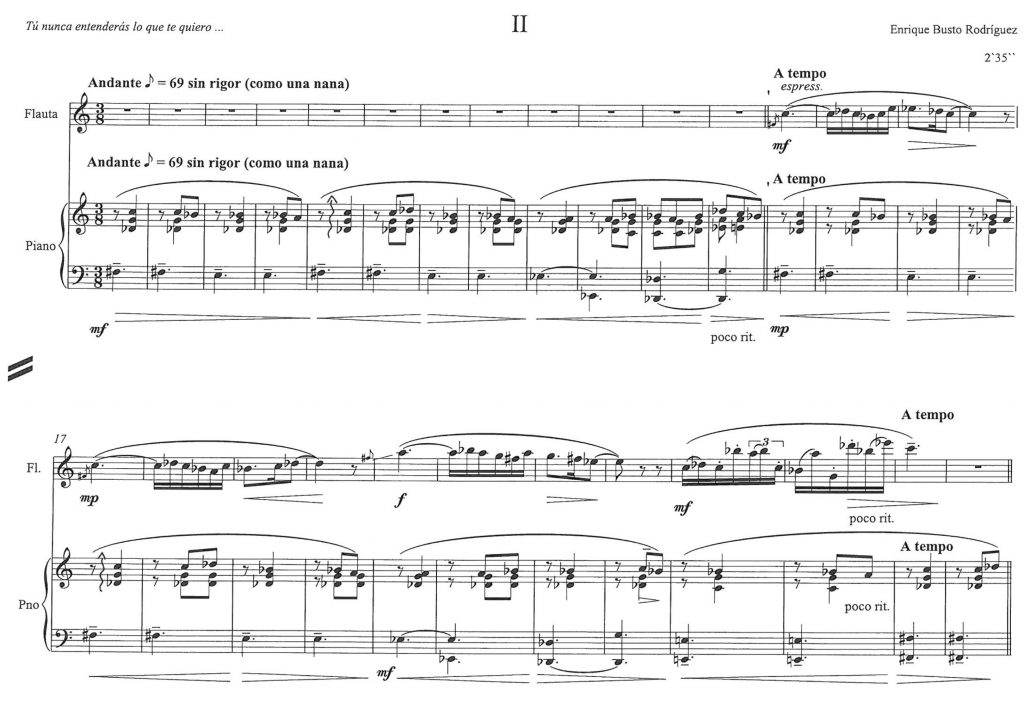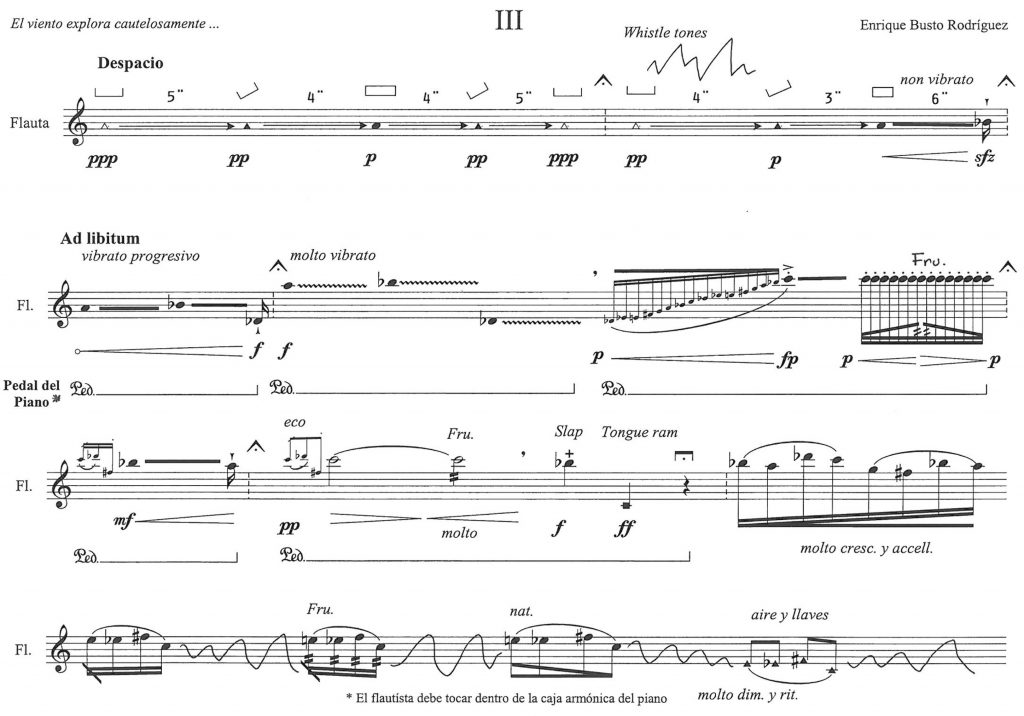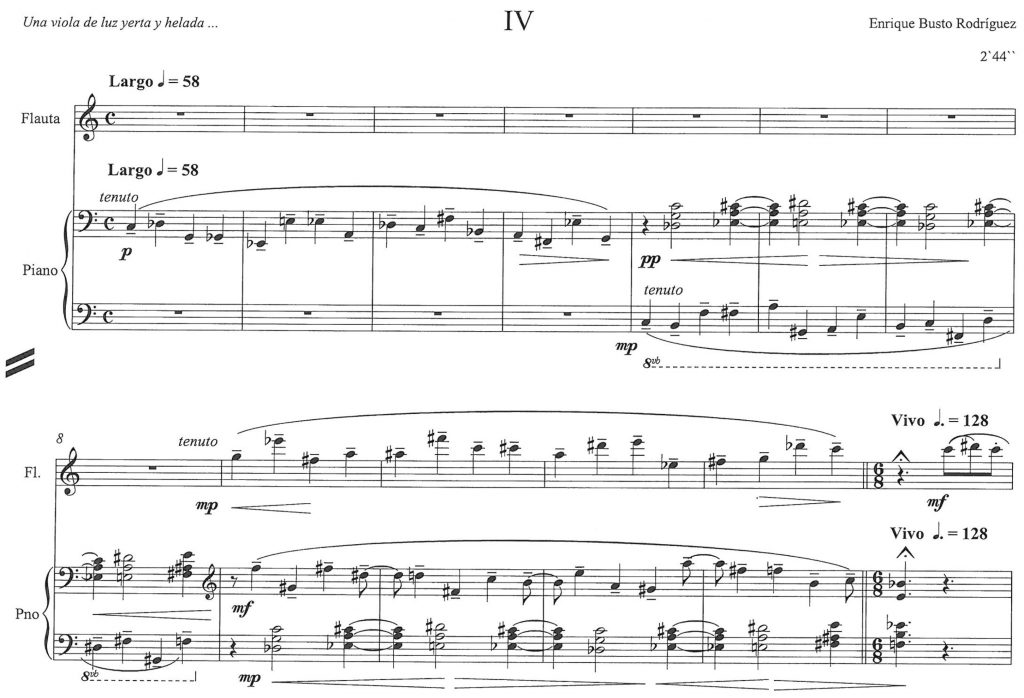
Instrumentation: Reciter, Flute in C and Piano
Duration: a.c. 10:30 minutes
Year of composition: 2002-03
Premiere: May 23, 2003. “Manuel Castillo” Superior Conservatory of Music in Seville.
Auxiliadora Gil (Piano)
Sara Martín (Flute)
Fernando Sáiz (Reciter)
Observations: Composition Honor Award granted by the “Manuel Castillo” Superior Music Conservatory of Seville. Dedicated to the memory of Federico García Lorca
Program notes:
“Sonetos” for flute and piano, is a piece divided into four movements and inspired by four sonnets by Federico García Lorca, a poet to whose memory it is dedicated.
It arises as a result of the final studies of composition at the Superior Conservatory of Music “Manuel Castillo” in Seville under the tutelage of Ignacio Marín.
In its elaboration, the composer was very influenced by the precepts that Oliver Messiaen collects in his treatise “My musical language”, as we can highlight in the use of modes with limited transpositions, non-retrogradeable rhythms, melodic contours inspired by the songs of the birds, ….
Each movement aims to show us different perspectives on the instruments involved. The last being, as a compilation of its predecessors, a cyclical movement to close the work.
As an interpretive suggestion, the author proposes that during the concert, each movement be introduced by reading its corresponding poem.
1st Movement:
We find an introduction “ad libitum” in which the measure is annotated with a special spelling that offers a certain freedom to the performers, to then move on to the movement itself, which is characterized by its rhythmic richness and energy, playing with the combination of different measures and accents, such as 3/8, 6/8 and 3/4 (not written but understood), very popular in the dances of southern Spain.
Soneto I
¡Esa guirnalda! ¡pronto! ¡que me muero!
¡Teje deprisa! ¡canta! ¡gime! ¡canta!
que la sombra me enturbia la garganta
y otra vez y mil la luz de enero.
Entre lo que me quieres y te quiero,
aire de estrellas y temblor de la planta,
espesura de anémonas levanta
con oscuro gemir un año entero.
Goza el fresco paisaje de mi herida,
quiebra juncos y arroyos delicados.
Bebe en muslo de miel sangre vertida.
Pero ¡pronto! Que unidos, enlazados,
boca rota de amor y alma mordida,
el tiempo nos encuentre destrozados.
Federico García Lorca

2nd Movement:
It is the most melodic and expressive movement of the four. It is a lullaby, in which the two instruments carry out a continuous dialogue. First, the piano takes the accompaniment roll to finally take the lead voice with the contrapuntal accompaniment of the flute.
There is a version for Cello and Piano of this movement.
Soneto II
Tú nunca entenderás lo que te quiero
porque duermes en mí y estás dormido.
Yo te oculto llorando, perseguido
por una voz de penetrante acero.
Norma que agita igual carne y lucero
traspasa ya mi pecho dolorido
y las turbias palabras han mordido
las alas de tu espíritu severo.
Grupo de gente salta en los jardines
esperando tu cuerpo y mi agonía
en caballos de luz y verdes crines.
Pero sigue durmiendo, vida mía.
¡Oye mi sangre rota en los violines!
¡Mira que nos acechan todavía!
Federico García Lorca

3rd Movement:
This movement is the most experimental of the four, in which the composer uses new extended techniques and new spellings to represent all of his inner imagination. It is divided into two sections: the first is an introduction to the flute solo in which the game with the air, slap, noise of keys and other resources, make this introduction a game of different atmospheres that will give way to the next section which consists of an ostinato that will lead to the climax of the piece.
Soneto III
El viento explota cautelosamente
qué viejo tronco tenderá mañana.
El viento: con la luna en su alta frente
escrito por el pájaro y la rana.
El cielo se coloca lentamente,
una estrella se muere en la ventana,
y en las sombras tendidas del Naciente
luchan mi corazón y su manzana.
El viento como arcángel sin historia
tendrá de largo acecho, la victoria,
mientras mi corazón en la luz fría
frente al vago espejismo de la Gloria,
lucha sin descifrar el alma mía.
Federico García Lorca

4th Movement:
In this fourth movement, structured in the shape of a rondo, themes from the previous movements appear, as a cyclical movement, which serves to give unity and close the work.
Soneto IV
Una viola de luz yerta y helada
eres ya por las rocas de la altura.
Una voz sin garganta, voz oscura
que suena en todo sin sonar en nada.
Tu pensamiento es nieve resbalada
en la gloria sin fin de la blancura.
Tu perfil es perenne quemadura.
Tu corazón paloma desatada.
Canta ya por el aire sin cadena
la matinal fragante melodía,
monte de luz y llaga de azucena.
Que nosotros aquí de noche y día
haremos en la esquina de la pena
una guirnalda de melancolía.
Federico García Lorca